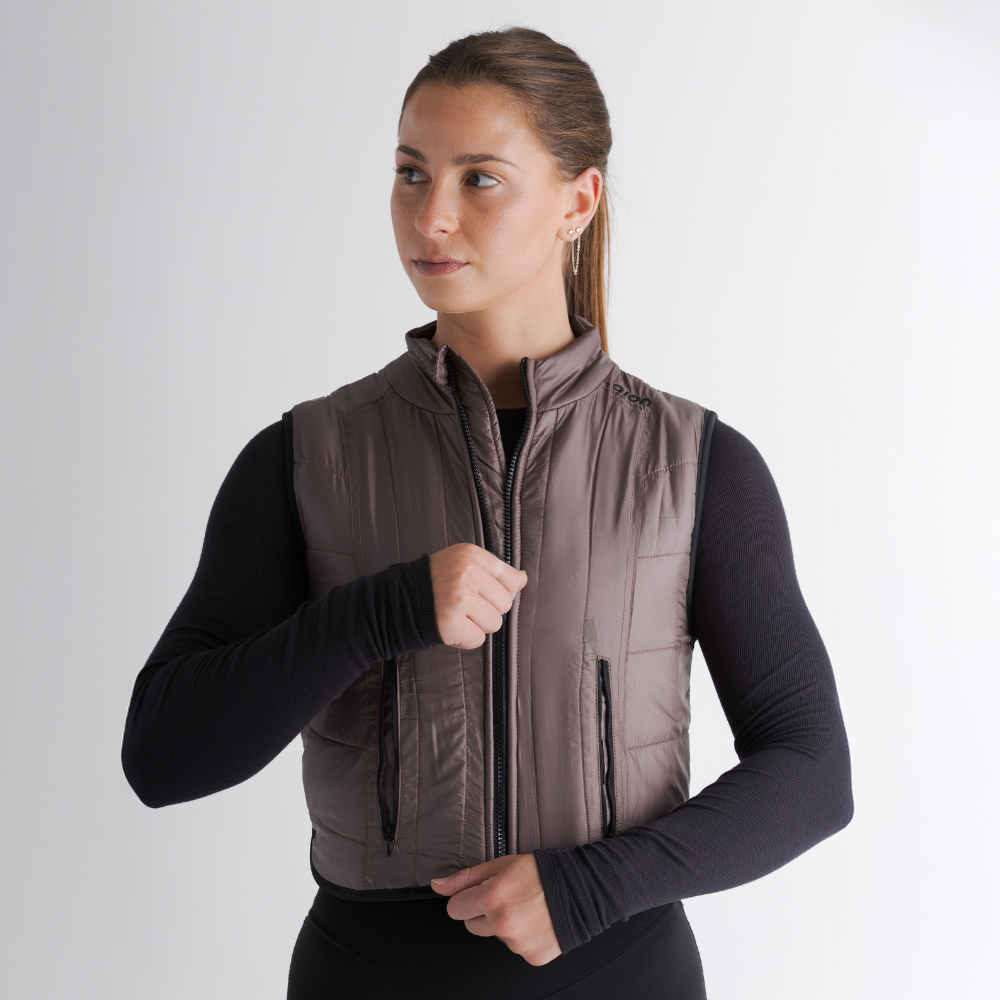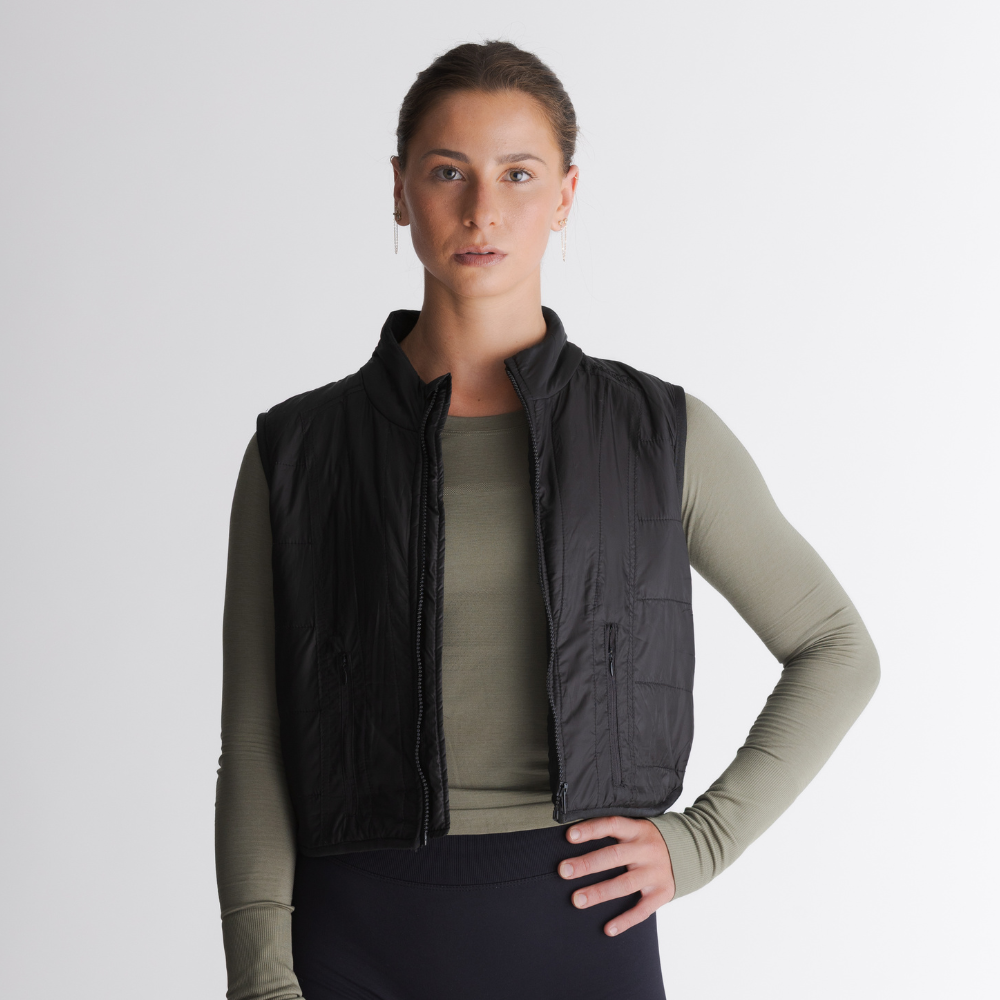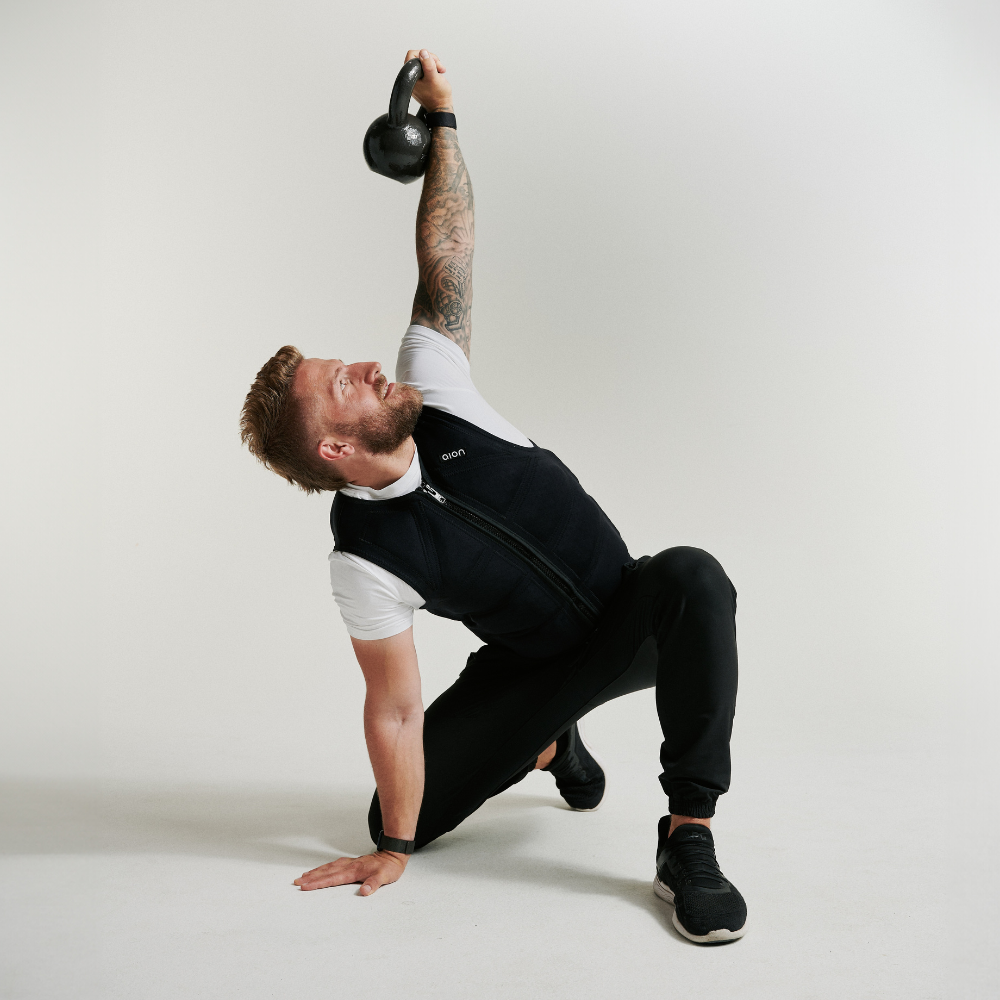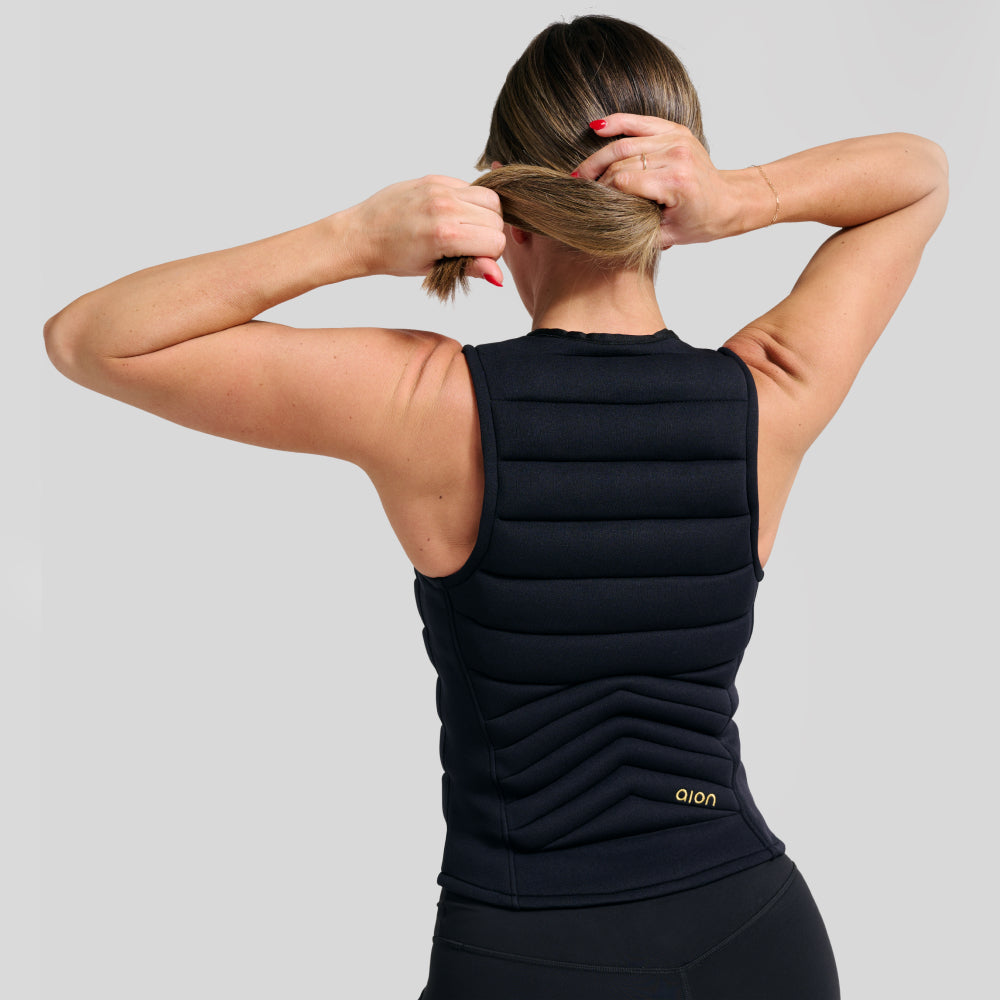Yes, you absolutely can! When used mindfully and with a focus on proper form, a weighted vest can be a powerful addition to your Pilates workout. It brings extra resistance that’s subtle but effective, especially for those looking to enhance core strength, improve posture, and support long-term bone health.
On its own, Pilates is already a fantastic form of low-impact exercise. It builds muscular endurance, enhances flexibility, boosts body awareness, and strengthens your spine and core. But if you want to take your practice to the next level and optimize those benefits, using a weighted vest like Aion’s during Pilates is a perfect combo!
If you’re curious about how to safely and effectively incorporate a weighted vest into your Pilates practice, you’re in the right place. In this post, we’ll break down why Pilates and weighted vests are such a powerful pairing, how adding extra resistance can help build stronger bones and improve posture, and how a vest compares to traditional Pilates tools. You’ll also find helpful safety tips for getting started, plus why the Aion weighted vest is uniquely designed to support functional movement, making it an ideal fit for Pilates.
The Power of Pilates
Even before you add weight, Pilates is already a powerful and deeply effective exercise. Developed in the early 20th century by Joseph Pilates, this system of controlled and mindful movements is designed to strengthen the body from the inside out. When doing your Pilates movements, you use your body’s muscle groups together, achieving integration of breath, alignment, stability, and flow.
Pilates has been shown to:
- Improve core muscle strength
- Help with body posture issues
- Increase flexibility and joint mobility
- Boost mind-body awareness
- Enhance balance and stability
Despite being a low-impact activity, Pilates is known to deliver full-body functional benefits. It’s popular among athletes, dancers, physical therapy patients, and everyday fitness enthusiasts alike because of its accessible yet challenging nature.
Resistance and Recovery Tools Common in Pilates
Pilates is known for its intentional movements and smart use of resistance, and over the years, a wide range of tools have been developed to deepen the practice. These tools help build strength, improve alignment, and support mobility—many of the same goals you can achieve by incorporating a weighted vest. Understanding how common Pilates equipment functions can help you see where a high-quality, body-hugging vest like Aion fits in and how it can elevate your sessions in a simple but powerful way.
Pilates Reformer
If you go to a Pilates studio, you’ve likely used a reformer. This is the gold standard in resistance-based Pilates. It consists of a sliding carriage and adjustable springs that provide different degrees of isolated resistance.
Resistance Bands and Loops
These are excellent for adding tension to upper and lower body movements. They are great at building muscle strength and increasing mobility. However, since these are made of elastic materials, their resistance can be inconsistent throughout movements.
Pilates Ring or Magic Circle
This tool is useful for performing isometric holds and activating the arm, inner thigh, and core muscles. It’s a great tool for creating body awareness and refining alignment.
Stability Ball and Foam Roller
These are commonly used for practicing balance, enhancing mobility, and boosting recovery. These tools are ideal for most physical therapy sessions, as they help with body awareness, spine flexibility, and coordination.
Ankle and Wrist Weights
Strapping these weights on offers targeted loading for specific muscles, especially in isolated limb movements. They can increase muscular effort in leg lifts, arm circles, and more.
Hand Weights or Dumbbells
These can be weighted balls or dumbbells that you can lift with your arms to improve upper-body resistance and coordination.
While each of these tools offers unique benefits, a weighted vest stands out for its versatility and simplicity. It adds full-body resistance without changing your range of motion or requiring special equipment, making it a seamless addition to any Pilates routine. Whether you're aiming to increase muscle endurance, improve bone density, or just make your core work a little harder, a well-designed vest like Aion’s is a smart, functional upgrade to your Pilates toolkit.
Weighted Vests: Resistance the Body Understands
Enter the weighted vest—a tool that adds resistance without restricting movement. Unlike ankle weights or dumbbells, a vest distributes weight evenly around your torso. That means:
- Your arms and legs stay free for dynamic movement.
- Your form and posture are not compromised.
- You get a natural resistance that doesn’t interfere with breath or alignment.
When you wear a weighted vest during your Pilates sessions, you add weight in the most organic way possible. This natural resistance increases the intensity of your Pilates movements but still allows you to move freely, maintain balance, and stay connected to your form. Additionally, the gravitational pull acts directly through your spine and core, stimulating not just muscles but also your skeletal system
Leveling Up Pilates with a Weight Vest: How it Compares to Other Pilates Equipment
While it doesn’t have to be an either/or approach, and you can use a weighted vest during Pilates along with all of the other tools listed above, here’s how the weighted vest compares to other Pilates tools:
- The Reformer - The weighted vest provides gravitational load that mimics real-life resistance, benefiting the whole body, not just isolated parts.
- Resistance Bands - The weighted vest provides constant bone-loading resistance, challenging your muscles and bones more consistently, especially in standing or upright exercises.
- The Magic Circle - The weighted vest provides bone-loading resistance that promotes bone density and skeletal strength. The Magic Circle is limited in toning specific muscle groups.
- Stability Balls & Rollers - The weighted vest adds weight close to the center of the body, which stabilizes the body’s center of gravity. A weighted vest is an ideal complement to balls and rollers. For example, doing leg lifts on a stability ball with a weighted vest activates even more core and stabilizing muscles.
- Ankle and Wrist Weights - The weighted vest keeps the added weight close to the body, promoting a more integrated and stable movement pattern. It also reduces the stress on the arm and ankle joints.
- Hand Weights or Dumbbells - The weighted vest lets you use your arms freely, letting you perform dynamic movements without the need to modify your grip or hand placement.
A weighted vest in your Pilates toolbox means adding a new layer of challenge to using the reformer or magic circle. It can also be a safe and convenient replacement for your ankle and wrist weights or dumbbells. And the benefits aren’t just physical—they’re efficient. As human biologist Gary Brecka puts it:
“You can take the workouts you're already doing and get more out of doing the same workout. When I first started incorporating a weighted vest into my workouts, the impact was immediate. I noticed improvements in my stamina, my energy levels, and my strength almost overnight. You're not just working harder, you're training smarter.” - Gary Brecka
In Pilates, where precision, control, and functional strength matter most, that’s exactly the kind of smart training that delivers results at any age.
Pilates, Weighted Vests, and Bone Health
By emphasizing posture, alignment, balance, and controlled movement, Pilates helps reduce fall risks and improves muscular support around your bones. However, these benefits do not guarantee bone health. Pilates alone lacks the mechanical loading that can stimulate your bones to grow stronger.
Why does bone loading matter? Bones are living tissues that rebuild and adapt to the forces placed on them. According to Wolff’s Law, bones become stronger when subjected to regular stress, especially through weight-bearing or resistance training.
Bone cells need the right kind of stress, through gravity and resistance, to grow and develop. That is why weight-bearing exercises like walking, jogging, or resistance training are often prescribed for bone health.
In our previous blog, we broke down how weighted vests can add the resistance that stimulates bone growth. Low-impact exercises like Pilates can achieve bone loading by using weighted vests to fill in what they lack in resistance.
Aion Weighted Vest and Pilates: The Best of Both Worlds
The Aion vest comes with a subtle yet effective load that will not drastically change the nature of your Pilates movements, but add just enough gravitational resistance to stimulate your bones. As a result, you can get the best of both worlds: The benefits of mindful movement through Pilates plus the functional resistance of weight training.
Aion’s patented fractional weight distribution ensures that weight is centered around your torso, increasing the bone-loading potential of your Pilates. The Aion vest fits snugly and comfortably, making it easy to add a gentle load without sacrificing mobility or form. And that’s key: bone-loading should never come at the cost of alignment or joint safety.
Incorporating Weighted Vests into Pilates
Ready to bring Aion to your Pilates mat? First, consider these best practices:
- Start light. Committing to an intense hour-long Pilates class might be a lot for your first time wearing a weighted vest! You can ease into it, wearing your vest for 15 minutes of class to start and gradually increasing that time as you grow stronger.
- Focus on form. Pilates is about precision, and even more so when wearing a weighted vest. Check your form in the mirror or work with your Pilates instructor to ensure you maintain proper form.
- Avoid overuse. You don’t have to wear the vest for every session, especially in the beginning. Listen to your body and give it time to adapt.
- If needed, seek a healthcare professional’s advice. Weighted vests are generally safe, especially Aion’s (due to the mindful design with fractional weight). However, you can always consult your doctor or physical therapist for personal guidance based on your body and health.

Why a Weighted Vest is the Missing Link in Your Pilates Practice
Adding a weighted vest to your Pilates routine is a simple change that delivers powerful results. It enhances what’s already great about Pilates—precision, posture, and mindful movement—while filling in what it traditionally lacks: full-body resistance and bone-loading benefits.
With a vest like Aion’s, you don’t have to overhaul your practice. You just wear it, move as you normally would, and let gravity do the rest. It’s resistance your body understands—natural, functional, and integrated into every breath and movement.
So if you’re ready to strengthen your bones, challenge your muscles, and move with even greater purpose, a weighted vest isn’t just a nice-to-have. It’s the next evolution of your Pilates practice. Shop Aion’s weighted vest collection and discover just how powerful mindful resistance can be.









